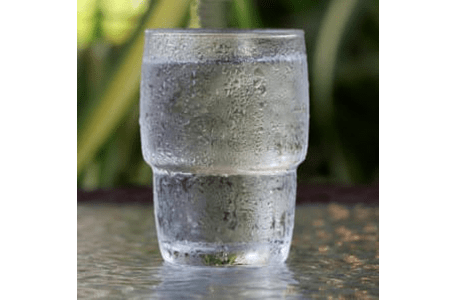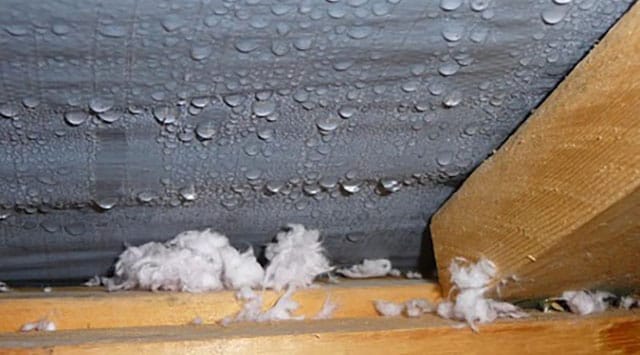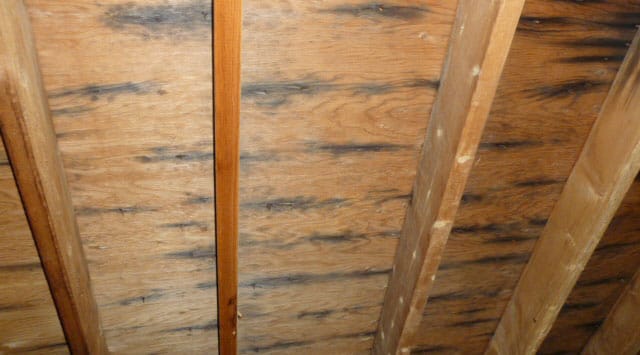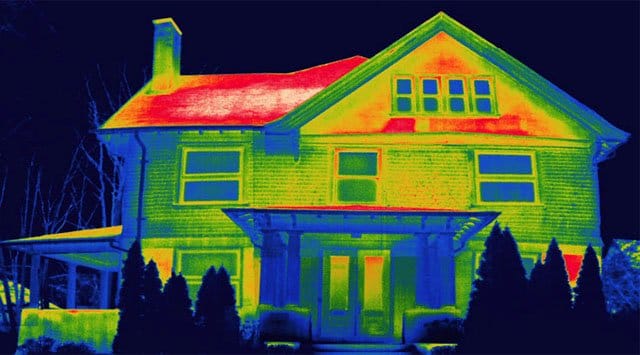Ceiling Stains
May Not Be A Roof Leak!
That Stain On The Ceiling May Not Be A Roof Leak!

When a homeowner sees a stain on the ceiling, the first (and most logical) reaction is “My roof is leaking, call the roofer!”
Calling a local roofing contractor is definitely a good idea, but it’s also a good idea to keep an open mind as well, especially if you noticed the stain or dampness on a dry, sunny day, particularly if it’s during the winter season.
The reason being is the stain or dampness could very well be the result of condensation and not a roof leak. The first thing a homeowner needs to understand is the power of condensation. Two great examples of how condensation works are as follows:
Condensation
Test One – The Leaking Glass of Lemonade/Ice Water
More than likely you have experienced a glass of ice cold lemonade or water on a hot summer day that had suddenly sprung a leak out of nowhere, requiring you to grab a towel or coaster, depending on how bad it was leaking, right? What do you mean the glass didn’t spring a leak? There’s no hole? Then where did all the water come from? That’s condensation! It forms whenever warm air meets cold air.

Test Two – The Self-Filling Water Bottle
Condensation can now fill containers with water! An industrial designer in Austria has come up with a way to convert humid air into drinkable water! This device takes warm, humid air and cools it. The result is water droplets, lots, and lots of water droplets, enough to fill an entire container! Think about what would happen if you went into your attic and dumped a bottle of water; it would more than likely stain the ceiling below and make it damp or wet, right?

What does this have to do with the stain on my ceiling?
The same process described in these two examples could very well be occurring in your home! Like the cold glass of water on a hot summer day and like the bottle that cools warm air to create water, there is a very good chance you have “warm living space air” and “cold attic space air” colliding in your attic. Creating…….you guessed it……..condensation!
Most homes have two environments, a warm living space environment, and a cold attic space environment. The goal is to keep the attic temperature as close to the outside temperature as possible to minimize ice dams and ice back-up on the roof (that’s an entirely different blog – Ice Dams 101). So, that means if it’s 15 degrees outside, ideally the attic space should be 15-17 degrees as well.
If My Attic Is 15-20 Degrees, What’s Going To Happen To My Heating Bills?
Great question! If your insulation is up to code, your bills won’t be affected at all! As a matter of fact, the condensation and staining are more than likely due to your home being under insulated.
Insulation is what separates the two environments we described above. If there is not enough insulation, the warm living space air rises into the attic, this is also known as heat loss, mixes with the cold attic air and creates condensation. Proper, up to building code insulation, on the other hand, keeps the warm air from exiting the living space and more importantly separate from the cold air in the attic.



Other types of heat loss into attic space can include recessed ceiling lights and bath or kitchen fans blowing warm, moist air into the attic instead of being vented through the roof. In addition to stains on your ceiling, other telltale signs of condensation in the attic are rusted nails, damp roof deck and mold and mildew.
So is that stain on your ceiling a roof leak? It could be, but it might not be a bad idea to keep an open mind to the possibility that it might not be because of a roof leak, either. By all means, make a call to a local roofing contractor, but don’t be surprised if he/she asks you to think outside the box, they just may have a couple alternative ideas and solutions that make sense!
 Contact Us
Contact Us 1-866-782-9379
1-866-782-9379